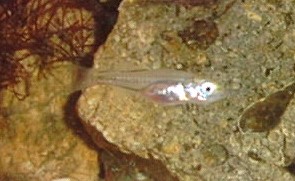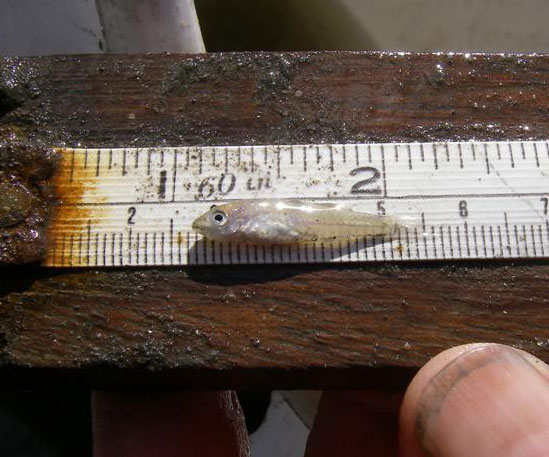
|
|
| Placozoa |
| Porifera |
| Cnidaria |
| Ctenophora |
| Mesozoa |
| Platyhelminthes |
| Nemertina |
| Gnathostomulida |
| Gastrotricha |
| Rotifera |
| Kinorhyncha |
| Loricifera |
| Acanthocephala |
| Entoprocta |
| Nematoda |
| Nematomorpha |
| Ectoprocta |
| Phoronida |
| Brachiopoda |
| Mollusca |
| Priapulida |
| Sipuncula |
| Echiura |
| Annelida |
| Tardigrada |
| Pentastoma |
| Onychophora |
| Arthropoda |
| Pogonophora |
| Echinodermata |
| Chaetognatha |
| Hemichordata |
| Chordata |
| TELEOSTEI |
|
|
 |
Common
Name(s):
Bass Sea Bass Scientific Name: Dicentrarchus labrax Family:
Moronidae
|
Photographs
by Andy Horton
| Identification:
Silvery streamlined fish with a pair of dorsal fins, the first spiny with 8 or 9 spines, and the second with the first ray spiny, followed by 12 or 13 soft rays. Medium-sized pectoral fins and slightly forked caudal fin. Sizes: 24 November 2007
Total
Fishing Report (with a photograph)
British Angling
Records:
First Notification by Daniel Ward on the Marine Wildlife of the North-east Atlantic Ocean Group Boat 8.88 kg (19 lb -09-02) off Reculver, Herne Bay P. McEwan 1987 Shore 8.62 kg (19 lb -00-00) South Breakwater, Dover D. L. Bourne 1988 World Angling Record: 9.40 kg (20 lb -11-00) Saintes Maries le Mer J. B. Bayle 1986 British Sea Fish Angling Records Similar species in British seas: Maigre
Drumfish (extremely rare) ,
Breeding: Offshore in spring.
Larvae grow to about 6 mm after 10 days.
Nursery Areas
Photographs by Nigel Knight Helford
River Bass Survey pictures
Bass (Index to British Marine Fish /External) Enemies: Porbeagle Shark Parasites: Lamprey Young Bass in a Home Aquarium Bass Fishery & Cetacean Bycatch, NE Atlantic by Nicolas De Meulan Jouault (Article) Early
September 2013
Sea
Angler Report & Image on facebook
Introductions
of Morone saxatilis
"I looked at the photographs and it looks more like an unusual European Bass, Dicentrarchus labrax, that is stripy and not a true Striped Bass, Morone saxatilis. The size and position of the eye coupled with the shape of the head and gill covers just looks more Dicentrarchus labrax."
Bass
with a blunt head
This most extraordinary looking Bass, Dicentrarchus labrax, was caught off the coast of Guernsey, tagged and returned to the sea. Its blunt head looks like that of the Pagrus Sea Bream and several other fish. This Bass weighed an estimated 4.5 kg. Report
by David
Wilkinson via Richard
Lord
(Guernsey)
14
February 2001
Report
by from Andrew Syvret via
Nicolas
Jouault
Photograph
February 2000 Pevensey Bay, Sussex: The estuary is back to normal again now, water levels are well up, higher than usual, and if the fine weather keeps up all will be well. The shoals of Bass were about yesterday again, mainly schoolies ranging from about 6" to 12" in size, with a smattering of much bigger fish in evidence. More. (Report
by Richard Huggett.) December 1999
A Bass
of nearly 6 kg (13 lb) was caught from the shore near Eastbourne,
East Sussex. (Report by Richard Huggett.)
25
August 1999
(Len
Nevell Sea Angling Reports) 22 September 1999
(Len
Nevell Sea Angling Reports)
Summer
1999
Pair trawlers from Newhaven fish for Bass very close in shore off Shoreham-by-Sea on 3 occasions, on one occasion with two pairs (4 trawlers). And April 2000. August 1998: Large Bass continue to be taken from the shore and piers at Shoreham-by-Sea, Sussex. The latest weighed 6.35 kg (14 lb). 12
January 1998: At the confluence of East and West Looe rivers,
Jon Makeham discovered 200 dead Bass,
Dicentrarchus labrax. This
marine fish enters estuaries during the summer and shoals of small fish
sometimes remain throughout the winter. The cause of the deaths is unknown.
The largest fish were 50 cm in length
Summer
1999
6 August
2000
Scottish Bass Report UK BASS Young Bass in the Adur Estuary 1999 Information wanted: Please send any records of this fish, with location, date, who discovered it, how it was identified, prevalence, common name and any other details to All messages will receive a reply.
|
|
|
|
|
|
|
|
|
 Very
young Bass (25 mm long)
Very
young Bass (25 mm long)

